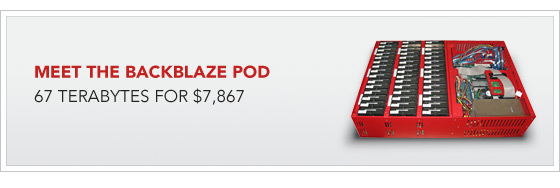Budget petabytes: How to build a cheap cloud storage

At Backblaze , we offer our customers unlimited storage for only $ 5 a month, so we had to figure out how to store hundreds of petabytes of client data in a reliable, scalable way, while keeping prices low. After looking at several commercial solutions with unreasonably high prices, we decided to build our own non-standard Backblaze storage containers (Backblaze Storage Pods): 67-terabyte 4U-servers for $ 7867.
In this posting, we will explain how to create such a storage container, and we will be happy if you use this design yourself. We hope that everyone will benefit from sharing this idea: both you and us, since you can improve this design and send us improvements. Evolution and cost reduction are critical to the continued success of Backblaze.
Here is a video showing the 3D model of a Backblaze storage container. Read on to learn about all the details of the design.
')
Here you can download the full 3-dimensional model of the Backblaze storage container in EASM format.
Backblaze need a large, reliable, cheap storage.
To say that Backblaze needs a large repository is to say nothing. We provide backup services, so our data center contains a complete copy of all our customer data, plus several versions of changing files. Roughly speaking, every time one of our customers buys a hard drive, Backblaze needs another 1 hard drive. For a long time, we stopped measuring storage in our data centers in gigabytes or terabytes and started to measure in petabytes.
To get an idea of how it looks, here in the photo I install new containers in our data center. I work with a rack containing a small “stack” of 6 containers containing almost half a petebyte of data in total.

In order to offer our services at a reasonable price, we need an affordable multi-petabyte storage.
Nobody sells cheap storages, so we designed them ourselves.
Before we realized that we would have to solve this problem with the storage ourselves, we looked at Amazon S3, Dell and Sun servers, NetApp filers, EMC SAN, etc. As we studied these traditional “ready-made solutions”, we lost all illusions about the cost. When you drop marketing terms and beautiful logos from any storage solutions, whatever you might say, the data is on a regular hard drive. But when we compared the prices of different boxed solutions, the cost was 10 or more times higher than the “raw” cost of hard drives. Here is a chart comparing the cost of 1 petabyte from various vendors:

After evaluating the costs, we decided to create our own Backblaze storage containers. We had 2 main objectives: to keep costs low, using consumer-level drives and readily available mass components, and use electricity and space in the data center as efficiently as possible, using “green” components and “cramming” a large storage into a small building.
The result is a 4U rack-mount server on Linux, containing 67 terabytes, with a cost price of $ 7,867, the lion's share of which is to buy the hard drives themselves. This is only ~ 0.3 cents per gigabyte per month for 3 years. Even including additional costs, such as electricity, traffic, rental space, and the salary of IT administrators, Backblaze spends 1/10 of the price compared to using Amazon S3, Dell servers, NetApp filers, or EMC SAN.
What is the storage container Backblaze
Backblaze Storage Container is a self-contained node that makes storage available online. It is a custom-made metal case with widely available budget accessories inside. More specifically, 1 container includes 1 Intel motherboard with 4 SATA cards inserted into it. 9 SATA cables extend from the boards to the 9 port multiplier panels (port multiplier backplanes), each of which is directly inserted into 5 hard drives (a total of 45 hard drives).

Above you see a detailed diagram, and you can see a detailed list of components in Appendix A. 2 main factors to mention are: the cost of hard drives is the lion’s share of the cost of the entire container, and the rest of the system is fully built on widely available budget components.
Read the article here.
Source: https://habr.com/ru/post/68832/
All Articles